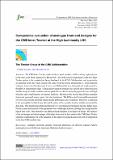Por favor, use este identificador para citar o enlazar a este item:
http://hdl.handle.net/10261/260877COMPARTIR / EXPORTAR:
 SHARE SHARE
 CORE
BASE CORE
BASE
|
|
| Visualizar otros formatos: MARC | Dublin Core | RDF | ORE | MODS | METS | DIDL | DATACITE | |

| Título: | Comparative evaluation of analogue front-end designs for the CMS Inner Tracker at the High Luminosity LHC |
Autor: | CMS Collaboration; Duarte Campderros, J. CSIC ORCID ; Fernández-García, Marcos CSIC ORCID ; García Alonso, A. CSIC ORCID; Gómez, Gervasio CSIC ORCID ; González Sánchez, J. CSIC ; Jaramillo, R. CSIC ORCID ; Moya, David CSIC; Ruiz Jimeno, Alberto CSIC ORCID ; Scodellaro, Luca CSIC ORCID ; Vila, Iván CSIC ORCID; Vizán, J. CSIC ORCID | Fecha de publicación: | 2021 | Editor: | IOP Publishing | Citación: | Journal of Instrumentation 16: P12014 (2021) | Resumen: | The CMS Inner Tracker, made of silicon pixel modules, will be entirely replaced prior to the start of the High Luminosity LHC period. One of the crucial components of the new Inner Tracker system is the readout chip, being developed by the RD53 Collaboration, and in particular its analogue front-end, which receives the signal from the sensor and digitizes it. Three different analogue front-ends (Synchronous, Linear, and Differential) were designed and implemented in the RD53A demonstrator chip. A dedicated evaluation program was carried out to select the most suitable design to build a radiation tolerant pixel detector able to sustain high particle rates with high efficiency and a small fraction of spurious pixel hits. The test results showed that all three analogue front-ends presented strong points, but also limitations. The Differential front-end demonstrated very low noise, but the threshold tuning became problematic after irradiation. Moreover, a saturation in the preamplifier feedback loop affected the return of the signal to baseline and thus increased the dead time. The Synchronous front-end showed very good timing performance, but also higher noise. For the Linear front-end all of the parameters were within specification, although this design had the largest time walk. This limitation was addressed and mitigated in an improved design. The analysis of the advantages and disadvantages of the three front-ends in the context of the CMS Inner Tracker operation requirements led to the selection of the improved design Linear front-end for integration in the final CMS readout chip. | Descripción: | The Tracker Group of the CMS Collaboration: et al. | Versión del editor: | https://doi.org/10.1088/1748-0221/16/12/P12014 | URI: | http://hdl.handle.net/10261/260877 | DOI: | 10.1088/1748-0221/16/12/P12014 | E-ISSN: | 1748-0221 |
| Aparece en las colecciones: | (IFCA) Artículos |
Ficheros en este ítem:
| Fichero | Descripción | Tamaño | Formato | |
|---|---|---|---|---|
| comparativeLHC.pdf | 4,36 MB | Adobe PDF |  Visualizar/Abrir |
CORE Recommender
SCOPUSTM
Citations
6
checked on 21-abr-2024
WEB OF SCIENCETM
Citations
3
checked on 18-feb-2024
Page view(s)
26
checked on 24-abr-2024
Download(s)
31
checked on 24-abr-2024
Google ScholarTM
Check
Altmetric
Altmetric
Este item está licenciado bajo una Licencia Creative Commons

